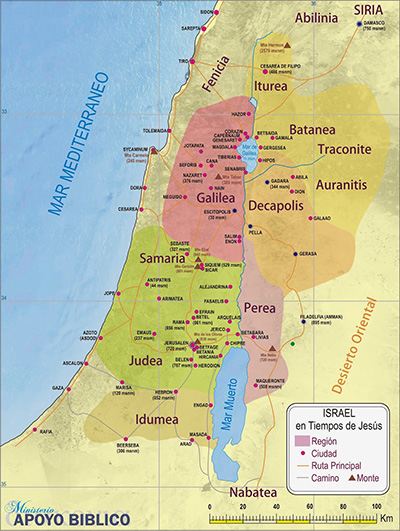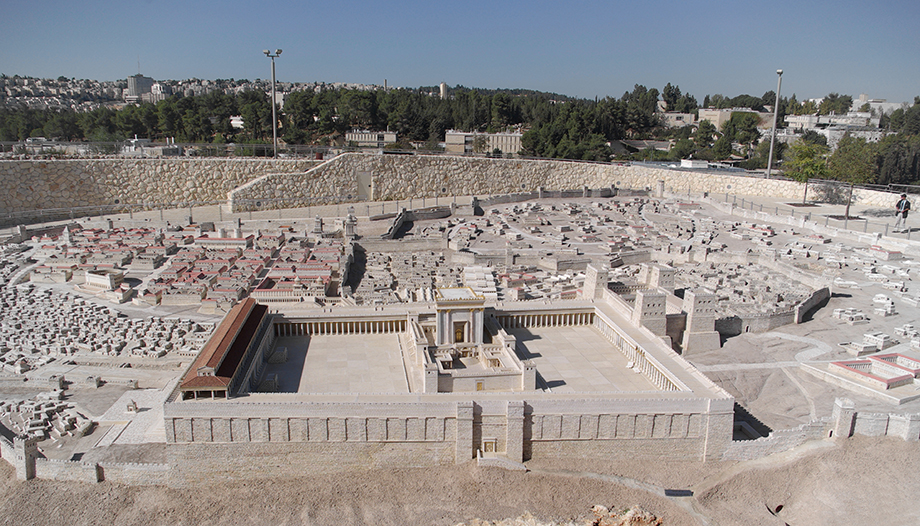 Rediscovering the Holy Land
Rediscovering the Holy Land Pilgrimages to the Holy Land after the pandemic
Pilgrimages to the Holy Land after the pandemic Way of the Cross in Jerusalem. Where the footsteps of Christ resound
Way of the Cross in Jerusalem. Where the footsteps of Christ resoundAs we approach the Gospels, we glimpse the social landscape of what we know today as the Holy Land at the time of Jesus. The history of this land and of the peoples who have inhabited it throughout the centuries, frame the life of Christ on earth and provide a valuable framework for interpretation to relive and discover all the richness contained in the scriptures.
A land that has always been complex
At the time of Jesus, the Holy Land was not called Palestine. This name, in fact, was given to it by Emperor Hadrian from 135 AD, at the end of the Third Jewish War. At that time it was not even a single unicumThe Kingdom of Israel, geographically, politically, culturally and religiously, if it had ever been one. In fact, the ancient Kingdom of Israel had long since ceased to be an independent state and was divided between Judea, immediately subject to Rome and ruled by a praefectusand the other two historical regions, Galilee and Samaria.

However, Judea remained the heart of Jewish worship, since there, in Jerusalem, was the Temple, to which all the Jews scattered throughout the world went.
On the other hand, Samaria, the central plateau of what is known today as Palestine or Israel, was inhabited by the Samaritans, a population resulting from the fusion of the settlers brought by the Assyrians in the 5th century B.C., at the time of the conquest of the Kingdom of Israel, and the local proletarians, left by the conquerors, who had deported the notable Israelites to Assyria.
The mixture had given rise to a cult that at first was syncretic, but which was later refined until it became monotheistic, although in contrast to the Jewish one. In practice, both Jews and Samaritans considered themselves the sole and legitimate descendants of the patriarchs and custodians of the Covenant with Yahweh, the Law and the cult. The former, however, had their center of worship in Jerusalem, the latter in a temple on Mount Garizim, near the city of Shechem. We know from the Gospels, but not only, that Jews and Samaritans detested each other.
Galilea
Galilee was an area of mixed population: Jewish towns and cities (e.g., Nazareth, Cana) were found next to cities of Greco-Roman and then pagan culture (e.g., Sepphoris, Tiberias, Caesarea Philippi). The population of the region, although of Jewish faith and culture, was despised by the inhabitants of Judea, who boasted of being purer and more refined. Several times, about Jesus, we hear it said in the Gospels that "nothing good can come out of Nazareth or Galilee". By the way, not only the Gospels tell us, but also the few remaining rabbinical writings of that time, that the Galileans were also mocked for their way of speaking. Hebrew and Aramaic (a lingua franca spoken throughout the Middle East at that time), like all Semitic languages, have many guttural letters and aspirated or laryngeal sounds. And the Galileans pronounced many words in a manner considered funny or vulgar by the Jews. For example, the name יְהוֹשֻׁעַ, Yehoshu‛a, was pronounced Yeshu, hence the Greek transcription Ιησούς (Yesoús), later changed to the Latin Jesus.
Galilee, however, constituted a vassal kingdom of Rome and was ruled by the tetrarch Herod, a king of pagan origin literally put on the throne by Augustus. Herod, known for his cruelty but also for his cunning, had done everything possible to win the sympathy of the Jewish people, including having the Temple of Jerusalem (which had been rebuilt by the people of Israel after their return from the Babylonian captivity) enlarged and embellished. Work to complete the structure was still in progress while Jesus was alive and was completed only a few years before 70 A.D., when the sanctuary itself was razed to the ground during the destruction of Jerusalem by the Romans led by Titus.
Next door, further to the northeast, beyond the eastern shore of Lake Galilee, was a confederation of ten cities (the Decapolis), representing a Hellenized cultural island.
The destruction of the Temple and the Diaspora
The Diaspora, that is, the dispersion of the Israelites to the four corners of the planet had already begun between 597 and 587 B.C., with the so-called "Babylonian captivity", that is, the deportation of the inhabitants of the kingdoms of Israel and Judah to Assyria and Babylon, and with the destruction of the Temple built by Solomon, by King Nebuchadnezzar. In the year 538, with the Edict of Cyrus, king of the Persians, part of the Jews were able to rebuild the Temple upon returning to their country, although many Jews remained in Babylon or went to live in other regions, a process that continued in the Hellenistic and Roman era.
However, it was Rome that put an end - and for almost two thousand years - to the national and territorial aspirations of the Jewish people, with the bloody three Jewish Wars.
The first of these (66-73 A.D.) culminated in the destruction of Jerusalem and the Temple, as well as other cities and military fortresses such as Masada, and the death, according to the historian of the time, Josephus Flavius, of more than one million Jews and twenty thousand Romans. The second (115-117) took place in the Roman cities of the Diaspora and also claimed thousands of victims. In the third (132-135), also known as the Bar-Kokhba Revolt (after Shimon Bar-Kokhba, the leader of the Jewish rebels, who at first was even proclaimed messiah), the Roman war machine ran like a steamroller over everything it encountered, razing some 50 cities (including what was left of Jerusalem) and 1000 villages. Not only the rioters, but almost the entire Jewish population that had survived the First Jewish War was annihilated (there were approximately 600,000 dead) and the damnatio memoriae led to erase the very idea of a Jewish presence in the region, which was Romanized even in the topography.
The name Palestine, in fact, and more precisely Syria Palæstina (Palestine proper was, until then, a thin strip of land, corresponding more or less to today's Gaza Strip, in which was located the ancient Philistine Pentapolis, a group of five city-states inhabited by an Indo-European speaking population historically hostile to the Jews: the Philistines), was attributed by the emperor Hadrian to the ancient province of Judea in 135 AD.C, after the end of the Third Jewish War. The same emperor had Jerusalem rebuilt as a pagan city, under the name of Aelia Capitolina, placing temples of Greco-Roman gods just above the Jewish and Christian holy places (Jews and Christians were then assimilated).
The Holy Land as a pedagogy of Jesus
The Holy Land has been repeatedly referred to as the Fifth Gospel. The last, in order of time, to refer to it in this sense has been Pope Francis, when receiving the Delegation of the Custody of the Holy Land at the Vatican, in January 2022, he said: "to make known the Holy Land means to transmit the Fifth Gospel, that is, the historical and geographical environment in which the Word of God was revealed and then became flesh in Jesus of Nazareth, for us and for our salvation".
That the Holy Land is a bit like the Fifth Gospel is demonstrated by Jesus' own life and his tireless walk through this land to fulfill his mission there.
We know that this mission of Jesus is the abasement of God toward man, defined in Greek as κένωσις (kénōsis, "emptying"): God lowers himself and empties himself; he divests himself, in practice, of his own divine prerogatives and attributes in order to share them with man, in a movement between heaven and earth. This movement involves, after a descent, also an ascent from earth to heaven: the théosis (θέοσις), the elevation of human nature that becomes divine because, in Christian doctrine, the baptized man is Christ himself. In practice, the lowering of God leads to the apotheosis of man.
We see the abasement of God for the apotheosis of man in various aspects of the human life of Jesus, from his birth to his death on the cross and his resurrection. But we also see it in his preaching of the Gospel to the Land of Israel, from the beginning of his public life, with his baptism in the Jordan River by John the Baptist, to his determined journey to Jerusalem. Curiously, the baptism in the Jordan takes place at the lowest point of the earth (precisely the banks of the Jordan, in the vicinity of Jericho, 423 meters below sea level) and the death and resurrection in what was considered, in the Jewish tradition, the highest point: Jerusalem.
Jesus, therefore, descends, like the Jordan (whose Hebrew name, Yarden, means precisely "he who descends") to the Dead Sea, a deserted, bare and low place that symbolizes the abysses of sin and death. However, he then ascends to Jerusalem, the place where he would be "lifted up" from the earth. And he goes up there, as did all the Jews before him, on pilgrimage. By extension, we find this idea of pilgrimage, of "ascension," in the modern concept of 'aliyah), a term that defines both the pilgrimage to Israel of Jews (but also of Christians) and immigration and settlement (pilgrims and emigrants are called 'olim-from the same root "'al"-meaning 'those who ascend'). Even the name of the Israeli flag carrier El Al means "upward" (and with a double meaning: "high" is the sky, but "high" is also the Land of Israel). An ascent, then, in every sense.
Writer, historian and expert on Middle Eastern history, politics and culture.











